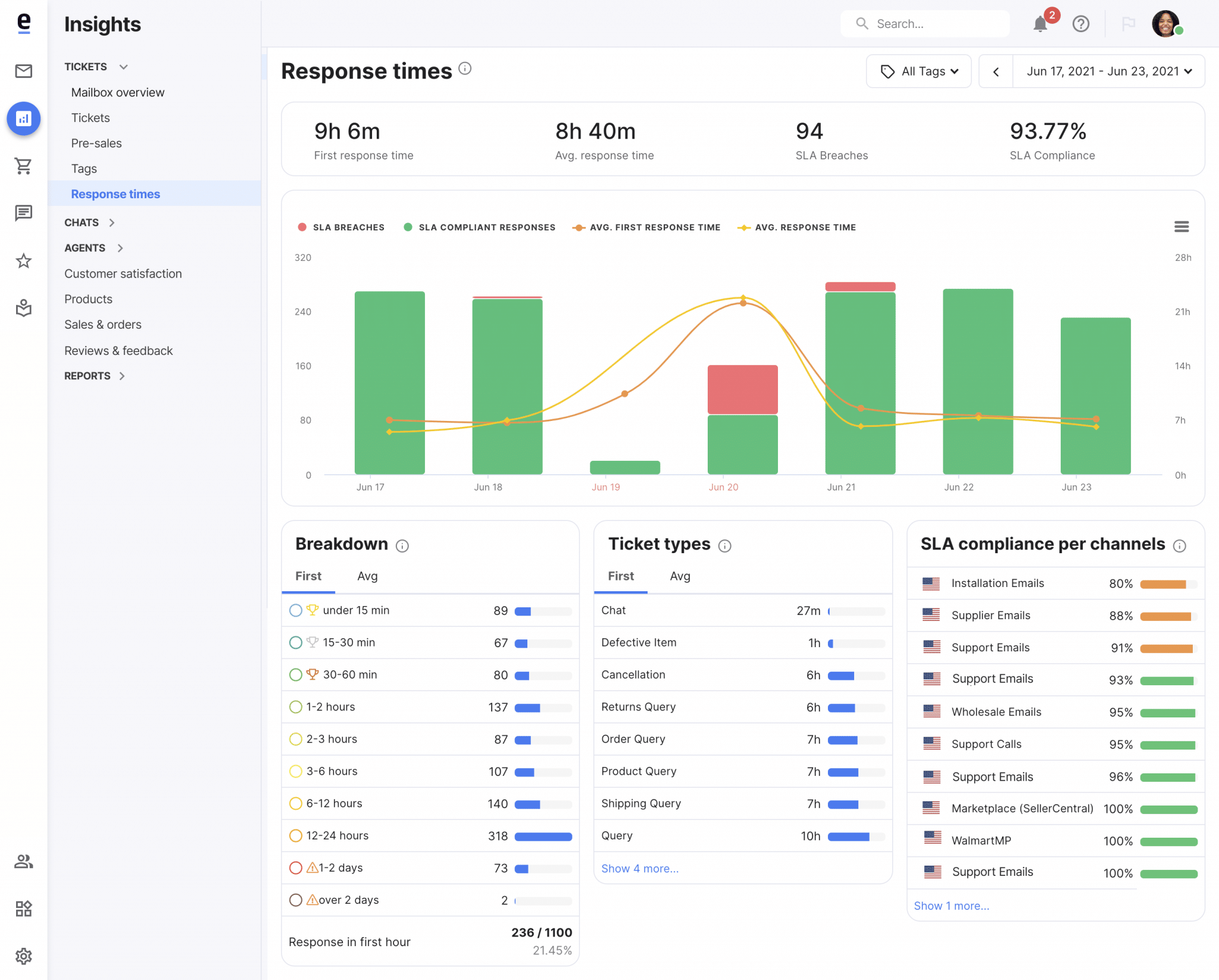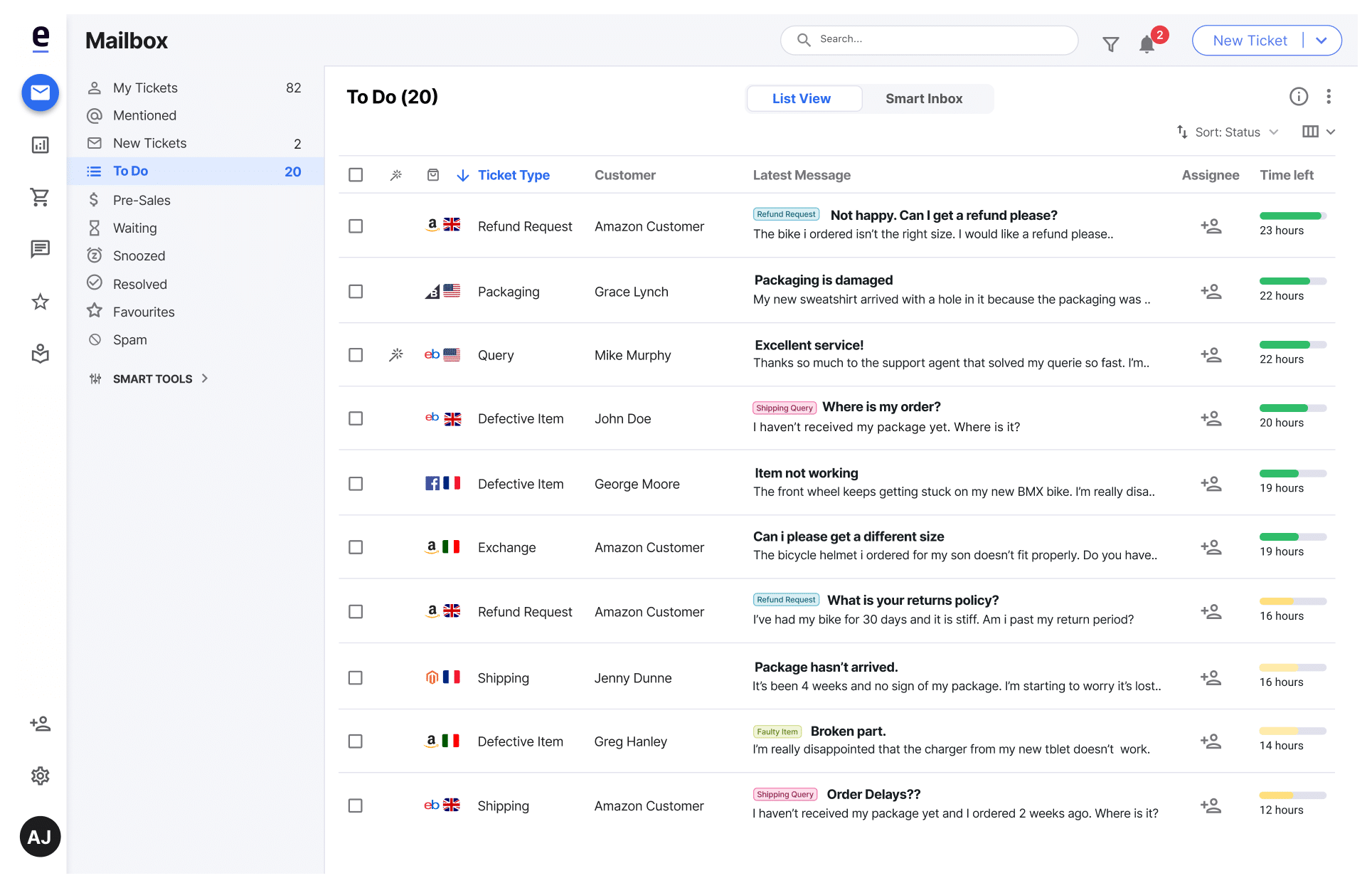Nel mondo competitivo di oggi, il servizio clienti deve garantire un’esperienza superiore. Ciò significa che i migliori marchi devono competere per fornire ai loro clienti non solo il miglior servizio clienti, ma anche i tempi di risposta più rapidi. È semplicemente quello che ci si aspetta!
Poiché le aziende sono sempre più incentrate sul cliente, i tempi di risposta sono un elemento importante per offrire una migliore esperienza al cliente e la capacità di rispondere ai clienti in tempi rapidi è una parte fondamentale per conquistare la loro fedeltà. Anche se sembra che sia un dato di fatto da sempre, solo 10 anni fa il tempo medio di risposta accettabile per i clienti era di 24 ore. Da allora è stato considerato il tempo di risposta “standard” per rispondere tempestivamente a un cliente ed esercitare un buon servizio clienti. Ma dato che da allora i metodi di risposta istantanea si sono evoluti fino a includere i social media e la messaggistica, non sorprende sapere che i clienti di oggi si aspettano una risposta anche prima delle 24 ore standard dello scorso decennio. Infatti, un recente sondaggio ha rivelato che il 75% dei clienti afferma che l’attributo più importante del servizio clienti è un tempo di risposta rapido. È chiaro che le aspettative sui tempi di risposta rapidi stanno cambiando. Per tenere il passo, le aziende devono assicurarsi di adottare tutte le misure necessarie per ridurre i tempi di risposta. Ecco perché abbiamo realizzato questa utile guida che mostra cinque modi in cui la tua azienda può ridurre i tempi di risposta dei clienti, senza dover riorganizzare l’intero reparto di assistenza clienti. Basta apportare alcune modifiche al modo in cui gestisci il servizio clienti per ridurre i tempi di risposta e migliorare l’immagine che i clienti hanno della tua azienda.
Che cos’è il tempo di risposta del servizio clienti?

Il tempo di risposta del servizio clienti è semplicemente il tempo che un’azienda impiega per rispondere alla richiesta di un cliente, indipendentemente dal fatto che la richiesta arrivi tramite e-mail, telefono, social media, messenger o qualsiasi altro mezzo online. Il tempo di risposta non include i messaggi automatici. Quindi, anche se i chatbot sono un ottimo modo per dimostrare ai tuoi clienti che ci tieni e che sei attento, quando parliamo di tempi di risposta ci riferiamo specificamente al tempo necessario a un agente in carne e ossa per rispondere a un cliente e avviare il processo di risoluzione. Naturalmente, i tempi di risposta variano a seconda del metodo con cui i clienti contattano la tua azienda. Ad esempio, se chiamano il call center, è probabile che raggiungano subito un agente che li aiuti a risolvere i loro problemi. Mentre l’invio di un’e-mail di richiesta d’aiuto può richiedere diverse ore (o fino alle 24 ore standard) per essere attivato, semplicemente perché si tratta di una forma di comunicazione basata sul testo che viene gestita in modo diverso rispetto a una linea telefonica. Quindi, anche se i canali di comunicazione sono importanti, i tempi di risposta sono importanti sia separatamente che nel complesso.
L’obiettivo di ogni azienda dovrebbe essere quello di offrire tempi di risposta tempestivi e ragionevoli ai propri clienti, indipendentemente dal canale.
Qual è il tempo medio di risposta del servizio clienti e come calcolarlo?
Il tempo che un’azienda impiega per rispondere ai propri clienti è diverso per ogni azienda, quindi per capire e migliorare i tempi di risposta devi calcolare qual è il tempo di risposta della tua azienda. La comprensione dei tempi di risposta della tua azienda è nota anche come “tempo di prima risposta” (FRT), ovvero il tempo che un’azienda impiega per avviare l’assistenza clienti dopo la richiesta iniziale. L’FRT è un’importante metrica del servizio clienti utilizzata per valutare le prestazioni complessive del servizio clienti. È la metrica chiave utilizzata per determinare i tempi di risposta di un’azienda e se è necessario migliorarli. Calcolando l’FRT, un’azienda sarà in grado di identificare il tempo medio di risposta dell’intero servizio clienti. Come primo passo per capire e migliorare i tempi di risposta del tuo servizio clienti, devi prima calcolare l’FRT unico della tua azienda. Sì, l’FRT ha una formula! Fortunatamente è anche relativamente semplice:
- Innanzitutto, devi identificare un periodo specifico (ad esempio l’ultimo trimestre o gli ultimi sei mesi).
- Successivamente, dovrai esaminare il numero totale di risposte del servizio clienti in quell’arco di tempo e il tempo impiegato per rispondere alle domande dei clienti in quel periodo.
- Infine, dividi il tempo totale impiegato per rispondere per il numero totale di risposte.
Calcolando quanto sopra, il numero generato sarà il tuo tempo medio di prima risposta (FRT). Se vuoi andare oltre, puoi confrontare i tempi di risposta in periodi diversi, tra reparti diversi e persino tra agenti diversi. Una volta ottenuti i numeri, puoi confrontarli con i parametri di riferimento del settore, che sono:
- 24 ore per le e-mail
- 60 minuti o meno per i social media
- Tre minuti per il telefono
Se l’FRT del tuo team non è in linea con i benchmark del settore, o anche se lo è ma ritieni che ci sia un margine di miglioramento in alcune aree, puoi attuare i seguenti cinque semplici passi per migliorare l’FRT.
 Gli Approfondimenti di eDesk ti mostrano a colpo d’occhio il tempo di prima risposta, il tempo medio di risposta, le violazioni degli SLA e le risposte conformi agli SLA.[/caption]
Gli Approfondimenti di eDesk ti mostrano a colpo d’occhio il tempo di prima risposta, il tempo medio di risposta, le violazioni degli SLA e le risposte conformi agli SLA.[/caption]
5 modi per migliorare i tempi di risposta del tuo servizio clienti
1. Usa il giusto software per il servizio clienti
Il software per l’assistenza clienti è uno dei migliori investimenti che puoi fare per potenziare il tuo servizio clienti. Esistono diverse soluzioni di helpdesk che ti permettono di riunire tutte le richieste dei clienti, siano esse via e-mail, telefono, social media o messaggistica, in un’unica dashboard facile da usare che rende semplice per il tuo team di assistenza clienti rispondere e registrare in modo efficiente. Dando al tuo team di assistenza clienti uno strumento potente come il software di assistenza clienti, puoi aiutarlo a ridurre il tempo necessario per rispondere a ogni cliente. Saranno più organizzati, più efficienti e quindi in grado di elaborare un maggior numero di domande dei clienti nello stesso tempo che impiegherebbero a vagliare manualmente ognuna di esse. Quindi, un modo semplice e moderno per migliorare il tuo FRT e i tempi complessivi di risposta ai clienti è quello di adottare un software per l’assistenza clienti che renda la gestione delle domande dei clienti più semplice e snella. Correlato: Come CarParts.com ha ridotto i tempi di risposta dell’assistenza clienti
2. Usa un sistema di biglietteria prioritaria
 La Casella di Posta Intelligente di eDesk assegna una priorità ai ticket di assistenza per aiutare il tuo team a rispondere e risolvere più velocemente. Naturalmente sappiamo che ogni richiesta dei clienti è importante, ma per fornire un servizio clienti efficiente devi sapere come dare priorità alle richieste che ti arrivano in modo da ottimizzare il tempo e le risorse disponibili del tuo team. Un sistema di ticketing è l’ideale per questo scopo. Presente nella maggior parte dei software per l’assistenza clienti, un sistema di ticketing ti aiuta ad etichettare ogni richiesta dei clienti in base alla priorità, in modo da capire quali sono particolarmente urgenti e quali possono essere evase un po’ più tardi, ma comunque in modo tempestivo. Classificare le richieste ricevute in base all’argomento e alla complessità aiuta il tuo team clienti a essere più produttivo. Sapranno a quali dare la priorità e potranno lavorare in un contesto organizzato per dare la precedenza alle richieste più urgenti. Molte delle attuali soluzioni software per l’assistenza clienti offrono persino l’automazione per la definizione delle priorità delle richieste, eliminando così le congetture che si possono fare manualmente ed eliminando un’ulteriore fase della tua procedura. Correlato: Cos’è un sistema di ticket di assistenza e come utilizzarlo
La Casella di Posta Intelligente di eDesk assegna una priorità ai ticket di assistenza per aiutare il tuo team a rispondere e risolvere più velocemente. Naturalmente sappiamo che ogni richiesta dei clienti è importante, ma per fornire un servizio clienti efficiente devi sapere come dare priorità alle richieste che ti arrivano in modo da ottimizzare il tempo e le risorse disponibili del tuo team. Un sistema di ticketing è l’ideale per questo scopo. Presente nella maggior parte dei software per l’assistenza clienti, un sistema di ticketing ti aiuta ad etichettare ogni richiesta dei clienti in base alla priorità, in modo da capire quali sono particolarmente urgenti e quali possono essere evase un po’ più tardi, ma comunque in modo tempestivo. Classificare le richieste ricevute in base all’argomento e alla complessità aiuta il tuo team clienti a essere più produttivo. Sapranno a quali dare la priorità e potranno lavorare in un contesto organizzato per dare la precedenza alle richieste più urgenti. Molte delle attuali soluzioni software per l’assistenza clienti offrono persino l’automazione per la definizione delle priorità delle richieste, eliminando così le congetture che si possono fare manualmente ed eliminando un’ulteriore fase della tua procedura. Correlato: Cos’è un sistema di ticket di assistenza e come utilizzarlo
3. Utilizzare modelli e scorciatoie di testo
Inevitabilmente nel servizio clienti ci sono alcune domande che vengono poste più volte da molti clienti. A volte queste domande, pur essendo comuni, non sono particolarmente complesse e non richiedono una risposta pratica. Le domande più frequenti possono essere affrontate in modo rapido ed efficiente utilizzando dei modelli che contengono risposte già pronte. I modelli di e-mail che forniscono le informazioni giuste, in un messaggio chiaro, possono essere utilizzati dagli agenti per rispondere rapidamente ai clienti, senza dover digitare individualmente la stessa risposta più volte. Puoi creare dei modelli per ogni domanda che i tuoi clienti pongono di frequente, come ad esempio “Dove posso controllare il mio numero di tracking?” o “Come posso reimpostare la mia password?”, in modo che i membri del tuo team abbiano ogni risposta a portata di mano ogni volta che si presenta una domanda frequente dei clienti. In questo modo risparmieranno molto tempo nel gestire le richieste. Allo stesso modo, le scorciatoie di testo identificano le parole o le frasi più usate e possono creare risposte automatiche basate su queste parole chiave. In questo modo si riduce drasticamente il numero di battute che ogni agente impiega per digitare un messaggio di risposta al cliente in merito a problemi comuni. Inoltre, le scorciatoie di testo possono essere utilizzate per generare automaticamente link a documenti FAQ o a pagine di conoscenza sul tuo sito web, che permettono ai clienti di trovare risposte a molte domande e problemi comuni. Sia le scorciatoie di testo che i modelli di e-mail aiutano a ridurre il tempo necessario ai membri del tuo team per rispondere a un cliente. In questo modo il loro tempo si libera e possono gestire un maggior numero di richieste nello stesso tempo, riducendo il tempo medio di risposta.
4. Utilizza avvisi basati sul tempo
Ogni azienda che si concentra sul proprio servizio clienti vuole essere sicura di rispondere rapidamente per ottimizzare i tempi di risposta ai clienti. Tuttavia, ci sono casi in cui il ritardo nei tempi di risoluzione è fuori dal tuo controllo. Ad esempio, il tuo agente potrebbe essere in attesa di informazioni chiave da parte del cliente per poter risolvere la sua richiesta. In questa situazione, è importante segnalare le richieste dei clienti per un follow-up temporizzato, in modo che non finiscano nel dimenticatoio. L’utilizzo di avvisi a tempo è la scelta migliore in questo caso, perché significa che il tuo team verrà sempre avvisato entro un periodo di tempo prestabilito per risolvere la richiesta (se il cliente ha fornito le informazioni richieste) o per seguire il cliente per ottenere le informazioni richieste. In ogni caso, gli avvisi basati sul tempo assicurano che non si perda nulla. I membri del tuo team possono ovviamente creare avvisi manuali, ma è molto più efficace automatizzare questo processo utilizzando un software per l’assistenza clienti, la maggior parte dei quali dispone di pratiche funzioni in grado di etichettare automaticamente le nuove richieste con un timer.
5. Obiettivi realistici e ricompense funzionano!
Oltre a tutti gli strumenti di produttività e alle procedure sopra elencate che puoi utilizzare per aumentare i tempi di risposta, è importante non dimenticare uno dei modi più cruciali per aumentare i tempi di risposta: la motivazione del tuo team di assistenza clienti! Dopo tutto, migliorare i tempi di risposta è un lavoro di squadra e tutti devono sentirsi coinvolti, lavorando insieme per raggiungere un obiettivo entusiasmante. Per questo motivo, devi dare al tuo team obiettivi realistici da raggiungere quando si tratta di migliorare i tempi di risposta dei clienti. Se stabilisci degli obiettivi troppo irrealistici, puoi demoralizzarti. Invece, dai un’occhiata agli standard del settore e cerca di allineare i tuoi obiettivi con essi, utilizzando parametri di riferimento realistici per vedere come le procedure della tua azienda possono essere aggiornate per raggiungere tali obiettivi. Quando stabilisci degli obiettivi realistici per il tuo team e li incoraggi a raggiungerli, crei un ambiente motivante in cui i dipendenti si sentono autorizzati a dare il meglio di sé. Impostando un tono positivo e ottimista, i tuoi dipendenti saranno spinti non solo a raggiungere, ma anche a superare gli obiettivi che hai fissato. Anche offrire incentivi, come bonus di rendimento, giorni di vacanza aggiuntivi o premi speciali, può aiutare a motivare i dipendenti a fare del loro meglio per raggiungere i nuovi obiettivi di tempo di risposta che hai stabilito. In definitiva, se ristrutturi il tuo approccio al servizio clienti fornendo ai tuoi dipendenti un potente kit di strumenti (come un software per il servizio clienti e altri strumenti che facilitano il loro lavoro) e combinandolo con un ambiente motivante e orientato al raggiungimento di obiettivi, sarai sulla strada giusta per ridurre i tuoi FRT e i tempi di risposta complessivi.
Pensieri finali
Migliori tempi di risposta ai clienti significano migliori affari! Dopo aver messo in pratica questi cinque passaggi, dovresti essere in grado di ricalcolare il tuo FRT e vedere un miglioramento nei numeri. Vedrai la differenza non solo in un punteggio più basso, ma anche nel feedback dei tuoi clienti. Un FRT più basso e un programma di assistenza clienti più efficiente costituiscono la pietra miliare di un’azienda incentrata sul cliente che si distingue dalla concorrenza. Migliorando i tempi di risposta, migliorerai anche l’esperienza complessiva dei tuoi clienti, il che non passerà inosservato. Vedrai la differenza nei tuoi profitti, grazie al fatto che i clienti torneranno a frequentare la tua azienda più volte.
Il software eCommerce helpdesk di eDesk include una casella di posta elettronica centralizzata e condivisa per l’assistenza clienti multicanale che include Amazon, eBay, Walmart, Shopify, Facebook, Instagram e molto altro. Prenota una demo o provala GRATUITAMENTE per 14 giorni e scopri come eDesk può aiutarti a rispondere più velocemente e a creare clienti più felici.




